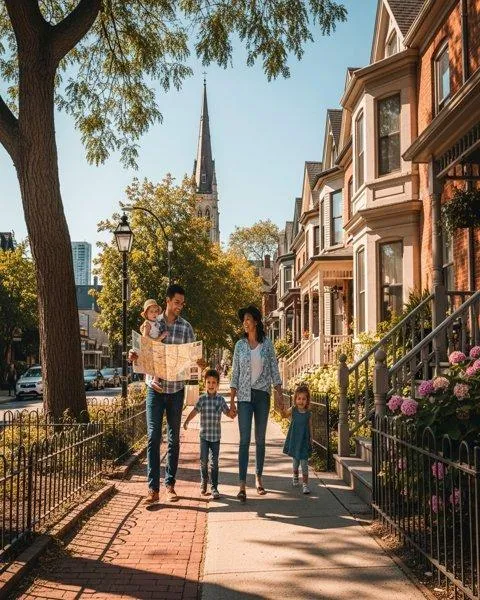
How Safe is Your New Neighborhood? Visit and See for Yourself!
How Safe is Your New Neighborhood? Visit and See for Yourself!
Deciding to move to a new home is a big step, especially if you're balancing the needs of your family, considering a transition stage in life, or navigating new opportunities. For those in the Dallas suburbs like Frisco, Plano, McKinney, Allen, and Prosper, new construction homes offer the chance to create your ideal space. But before you pack the moving boxes, there are a few things to think about. Here’s a guide to help you make the right choice when moving to a new community.
The Problem: Choosing the Right Community
Picking a new neighborhood involves more than just finding a house that looks good. It's about ensuring the community matches your lifestyle and meets your family's needs. Many families want homes in neighborhoods that offer parks, great schools, and easy access to work and social circles. But with so many options and possible fears of timing constraints or unexpected issues in the construction process, it’s important to take the right steps before moving.
The Agitation: Why It Matters
Choosing where to live can impact everything from your kids' education to your family’s daily commute. Many people worry about selling their current home for a good price while managing the construction of a new one. There are legitimate fears around construction delays, budget overruns, and the logistics of moving.
For families in the age range of 35 to 55, who have kids or are empty-nesters, selecting a place with good schools and family-friendly amenities is vital. Selling and moving can be a stressful process, but it's essential to ensure that your new community feels like the right fit.
The Solution: What to Check Before Moving
Here’s a list of things to think about before you move to your ideal Dallas suburb. These steps will help make sure your selected neighborhood meets your expectations and your family's needs:
1. Research Local Amenities and Lifestyle Fit
Before making a move, check out the local conveniences. Are there grocery stores, parks, hospitals, and schools nearby? Access to recreation opportunities and community resources is key. Make sure these align with your family’s daily needs.
2. Evaluate School Districts
School quality is crucial if you have kids. Check the local school district's performance and what extracurricular activities they offer. Good schools not only help your child's development but can increase home value over time.
3. Understand the Community Vibe
Visit the neighborhood at different times. This helps understand the social scene, age groups, noise levels, and overall feel. Knowing the demographic mix can help you see if the neighborhood is a good fit.
4. Check Safety Levels
Feelings of safety and comfort are crucial for any family. Check out local crime statistics and visit during different times of the day. This gives you a sense of the area's safety and noise levels.
5. Assess Walkability and Transportation
The ease of getting around impacts daily life. Check the neighborhood for its walkability and access to public transportation. Is it easy to get to work or school? This makes a big difference in day-to-day living.
6. Think About Logistical and Financial Considerations
Plan your budget carefully. Factor in moving fees, utility setup costs, and any unexpected expenses. Organize timelines to make sure you sell your current home and buy the new one smoothly. This avoids overlap and addresses concerns about timing.
7. Look for Neighborhood Amenities
Look beyond essentials to see what the community offers. Are there community centers, theaters, or local events? Parks, sports, and hobby groups can add to lifestyle satisfaction and community engagement.
8. Prepare for the Move
Create a checklist for moving. Plan out packing and labeling your belongings. Set up utilities in advance and arrange movers. Having a clear unpacking strategy can lead to less stress.
9. Consider Climate and Environment
Think about how the climate matches your family’s lifestyle. Dallas suburbs have different microclimates and outdoor options. Knowing what your family prefers can help in making a choice.
10. Participate in Community Involvement
Talking to potential neighbors and getting involved in local events helps make social connections. A sense of belonging can make the transition to a new neighborhood easier.
Why Take These Steps?
These considerations are about more than just making sure your house is pretty. They ensure your big investment meets the needs of your family and lifestyle. By thoroughly researching your new community, you can find a place that feels right for your family—poised for a fresh start with the promise of new beginnings.
Moving Forward: Transition with Confidence
Navigating a move involves many details, but with the right preparation, you can feel confident about your choice. A safe, inviting community that aligns with your needs can make the transition seamless. Plus, you'll enjoy the peace of mind that comes from knowing you've picked a home where you and your family can truly thrive.
Whether upsizing for more comfort or downsizing for simplicity, taking the time to ensure your chosen community meets your criteria is worth it. Remember to stay informed, plan thoroughly, and visit your potential neighborhoods to truly see if they match your vision.